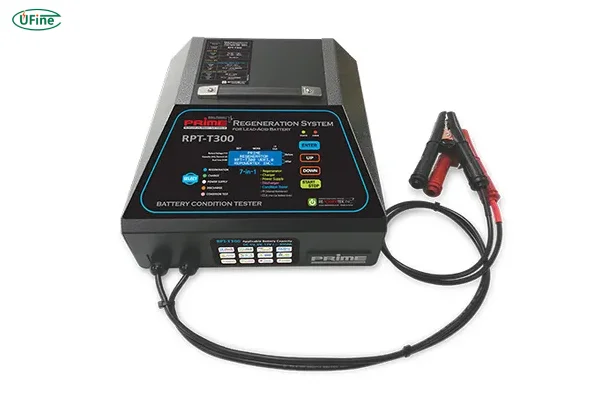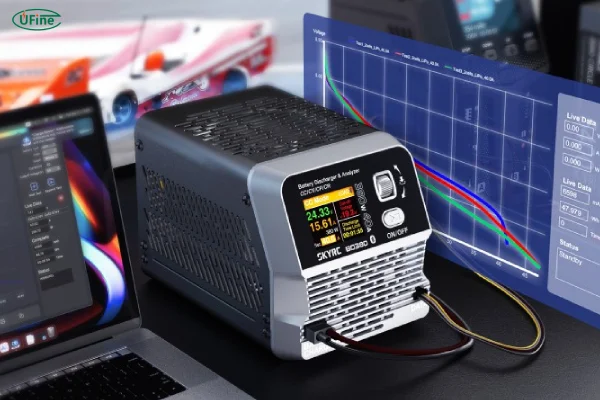Batteries power a vast array of devices, from everyday electronics to specialized industrial tools. However, maintaining their efficiency and longevity requires proper care and management. One essential tool for this purpose is the battery discharger. This device helps ensure batteries perform at their best, last longer, and stay safe during use.
In this article, we’ll explore what battery dischargers are, why they’re important, and how they work. We’ll also dive into specific applications for AA battery dischargers and lithium battery dischargers, providing detailed insights and actionable tips.
Part 1. What is the battery discharger?
A battery discharger is a device that removes stored energy from a battery in a controlled and safe manner. Its primary purpose is to optimize battery health by preventing overcharging, reducing memory effects, and calibrating capacity.
Battery dischargers are vital for:
- Testing a battery’s capacity and performance.
- Ensuring safe storage, especially for lithium-ion batteries.
- Prolonging battery life by maintaining proper charge-discharge cycles.
By discharging a battery to its ideal voltage level, you can protect it from damage and ensure consistent performance across its lifespan.
Your Ultimate Guide to Lipo Battery Dischargers
Part 2. How does a battery discharger work?
The operation of a battery discharger involves applying an electrical load to the battery, which allows it to release its stored energy in a measured and controlled manner. The process typically includes:
- Voltage Monitoring: The device tracks the battery’s voltage to ensure it remains within safe discharge limits.
- Steady Discharge Rate: It maintains a consistent energy release to avoid sudden drops that could harm the battery.
- Automatic Cut-Off: Most modern dischargers stop the process when the battery reaches its designated cut-off voltage, preventing over-discharge.
This structured approach ensures the battery is discharged without overheating, degrading, or losing efficiency.
Part 3. Benefits of battery dischargers
Using a battery discharger offers several significant advantages:
1. Extending Battery Lifespan
By regularly discharging and recharging, you can prevent common issues like capacity loss and voltage drops. This process is especially critical for rechargeable batteries like NiMH and lithium-ion.
2. Testing and Calibration
Battery dischargers allow users to measure the actual capacity of their batteries. This is invaluable for applications where precise performance is essential, such as in drones, medical devices, or industrial tools.
3. Safe Storage
For lithium-ion batteries, storing them at a specific voltage (usually around 3.7–3.9V per cell) is critical. A discharger ensures the battery is at the ideal voltage for long-term storage.
4. Environmental Benefits
Fully discharged batteries are safer to recycle. By discharging them properly, you contribute to safer and more eco-friendly recycling practices.
Part 4. AA battery dischargers
AA batteries are ubiquitous, powering everything from remote controls to portable tools. For those using rechargeable AA batteries, such as NiMH or NiCd, a AA battery discharger is indispensable.
Key Features of AA Battery Dischargers
- Multi-Slot Design: Discharge multiple AA batteries simultaneously.
- Digital Readouts: Display voltage, remaining capacity, and discharge progress.
- Adjustable Settings: Some models allow customization of discharge rates for different battery types.
Why Use a AA Battery Discharger?
Regularly discharging rechargeable AA batteries helps eliminate the memory effect—a phenomenon where batteries lose capacity if repeatedly charged without full discharge. This ensures the batteries retain their maximum potential over time.
Part 5. Lithium battery dischargers
Lithium batteries are more complex than AA or NiMH batteries, requiring precise charge and discharge management. A lithium battery discharger is specifically designed to handle the sensitive nature of lithium-ion and lithium-polymer cells.
Key Features of Lithium Battery Dischargers
- Voltage Precision: Ensures the battery discharges to a safe level without over-discharge, which could permanently damage it.
- High Load Capacity: Can handle the higher capacities and voltages typical of lithium batteries.
- Integrated Safety Mechanisms: Includes over-temperature, over-current, and short-circuit protections.
Applications of Lithium Battery Dischargers
Lithium battery dischargers are widely used in:
- Consumer Electronics: Smartphones, laptops, and tablets.
- Drones and RC Models: High-performance batteries require precise discharge for optimal efficiency.
- Electric Vehicles: Ensures battery packs are balanced and ready for use.
Part 6. Choosing the right battery discharger
When selecting a battery discharger, consider the following factors:
- Battery Type: Ensure compatibility with the specific battery chemistry, such as NiMH, NiCd, or lithium-ion.
- Capacity Range: Match the discharger’s capacity to your battery’s specifications.
- Adjustable Settings: Opt for devices with customizable discharge rates and cut-off voltages.
- Safety Features: Look for thermal management, over-discharge protection, and fault detection.
Part 7. Best practices for using battery dischargers
To maximize the benefits of a battery discharger, follow these tips:
- Monitor the Process: Keep an eye on voltage and temperature to ensure safe operation.
- Avoid Over-Discharge: Always set the cut-off voltage according to the battery type to prevent damage.
- Use the Correct Discharger: Ensure the device is compatible with your battery’s chemistry and specifications.
- Discharge Periodically: For rechargeable batteries, periodic discharging helps maintain capacity.
- Prepare for Storage: Before storing lithium batteries, discharge them to the recommended voltage.
Part 8. Final words
A battery discharger is a vital tool for maintaining and optimizing battery performance. Whether you’re working with AA batteries or advanced lithium cells, using a discharger ensures safety, efficiency, and longevity. By choosing the right discharger and following best practices, you can maximize the lifespan and effectiveness of your batteries.
Related Tags:
More Articles

How to Choose the Best Floor Scrubber Battery for Commercial Cleaning?
Selecting the ideal floor scrubber battery ensures a long runtime, rapid charging, and minimal maintenance for efficient commercial cleaning operations.
Battery for Blower vs Battery for Leaf Vacuum: Which One Should You Choose?
Battery for blower vs leaf vacuum—learn the key differences in power, fit, and runtime to choose the right battery for your outdoor tool needs.
How to Choose the Right Battery for Blower?
Choosing the right blower battery? Consider voltage, capacity, chemistry & usage. This guide helps match the best battery for peak performance.
How to Choose the Best Insulated Battery Box for Lithium Batteries?
Choosing the Best Insulated Battery Box for Lithium Batteries? Discover key factors such as size, material, and safety for optimal protection and performance.
7 Critical Elements on a Lithium Battery Shipping Label
What must be on a lithium battery shipping label? Learn 7 key elements to ensure safety, legal compliance, and correct handling across all transport modes.






